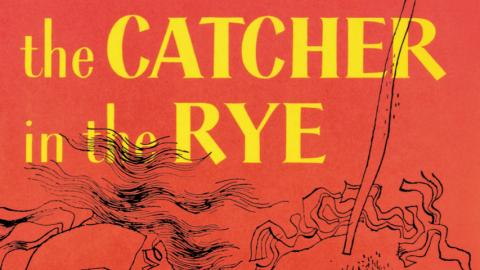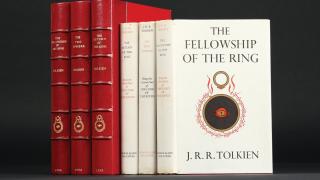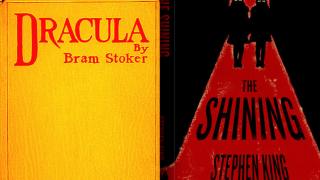Top 10 Greatest Novels of All Time

With these works of literature, authors turned inspiration into a lasting legacy. Join http://www.WatchMojo.com as we count down our picks for the top 10 greatest novels of all time. While self-help books and short stories are appreciated, our list focuses on novels by one specific author, which means The Bible failed to make the cut, as did a work like “Hamlet,” which is a play and not a novel.
Special thanks to our users MikeyP, serendipity456, Spencer Blyton, Rihards Raudonis, Michael Napoli, Cherrycat, Marlon Jacques, Julia Light, Kevin James Yannutz and Lucas Fuzato for submitting the idea on our Suggestions Page at WatchMojo.comsuggest
Top 10 Greatest Novels of All Time
Top 10 20th Century Novels
With these works of literature, authors turned inspiration into a lasting legacy. Welcome to WatchMojo.com, and today we’re counting down our picks for the top 10 greatest novels of all time. While self-help books and short stories are appreciated, our list focuses on novels by one specific author, which means The Bible failed to make the cut, as did a work like “Hamlet,” which is a play and not a novel.
#10: “To Kill a Mockingbird” (1960) Harper Lee
Top 10 Horror Novels
Told by Scout as a flashback to her childhood, “To Kill a Mockingbird” is the story of her father – morally upright lawyer Atticus Finch – who defends an innocent black man against a rape charge and teaches his children about racial equality. The lone novel written by Truman Capote’s childhood friend, it was an instant classic that won Harper Lee the Pulitzer Prize, Presidential Medal of Freedom and defined a generation.
#9: “Don Quixote” (1605-15) Miguel de Cervantes
Top 10 Fashion Trends of All Time
Considered the most important piece of writing to emerge from Spain’s Golden Age, “Don Quixote” sees a middle-aged man attempt to restore the chivalry he’s read about by going on a meandering quest, with his trusty squire Sancho Panza by his side. Translated into more languages than any other book – except the Bible – “Don Quixote” was released in two volumes separated by ten years. With shifting moralities, perspectives and narrations, this tale of honor and romance influenced many novels that followed it, including Alexandre Dumas’ “The Three Musketeers” and Mark Twain’s “Adventures of Huckleberry Finn.”
#8: “In Search of Lost Time” (1913-27) Marcel Proust
Top 10 Business Mergers of All Time
Whoever knew that a madeleine dipped in tea could stir such memories? Over 14-years in the early 20th-century, one writer eschewed the notion that plot must push a novel along. Proust’s seven volumes of towering prose, originally titled “À la recherche du temps perdu,” pervaded the collective consciousness of readers with dreamy imagery and reflective prose. Involuntary memory is the theme at the heart of the novel, with human senses guiding the narrative. Proust never stopped adding to his masterpiece until his untimely death. But fortunately for readers, “In Search of Lost Time” provides a lifetime of enjoyment.
#7: “The Catcher in the Rye” (1951) J. D. Salinger
Top 10 Greatest Banksy Pieces
For rebellious youths worldwide, this post-World War II novel offered a protagonist to identify with. Holden Caulfield originated in Salinger’s 1946 short story “Slight Rebellion off Madison,” and he takes us with him as he drifts around NY after his expulsion from prep school. With teen angst and disaffection at its core, “The Catcher in the Rye” was controversial as it featured slang, cursing and open discussions of teen sexuality. The most-banned book in the U.S. between 1961-82, its anti-establishment themes inspired a new wave of global writers and resulted in a cult following for the reclusive author.
#6: “Adventures of Huckleberry Finn” (1884) Mark Twain
After first appearing in the 1876 classic “The Adventures of Tom Sawyer,” social outcast Huck Finn appeared eight-years later in one of America’s most controversial novels. Based in a fictional town Missouri town, “Huckleberry Finn” takes us on a descriptive and educational trip along the Mississippi River, accompanied by a runaway slave, Jim. Written in colloquial speech, Twain’s novel was occasionally banned for its coarseness and critique of the South. However, its sometimes-satirical exploration of racism and societal pressures in pre-Civil War America opened the door for endless debate regarding ethical and cultural conflicts.
#5: “Lolita” (1955) Vladimir Nabokov
To be a young woman in the 1950s meant displaying the proper amount of grace, beauty and respect for elders. Russian novelist Vladimir Nabokov flipped the script on such ideals with his 1955 classic about a young temptress and the older man who desired her. While critics often debate the predatory instincts of the characters, “Lolita” opened up international dialogue on sexual abuse, literary morals and the comedic wordplay of Nabokov. Initially banned in parts of Europe, it was adapted by film director Stanley Kubrick, thus ensuring a lasting legacy in both media.
#4: “The Great Gatsby” (1925) F. Scott Fitzgerald
Top 10 Animals That Make Great Pets
One of America’s most beloved novels was born in the roaring ‘20s. Painting an opulent picture of life in the imagined town of West Egg, Long Island, “Gatsby” is a story about the fleeting nature of the American Dream. With the enigmatic Jay Gatsby and his fixation with Daisy Buchanan at its center, Fitzgerald’s story of new money and of love lost was not an immediate hit, only selling 20,000 copies in its first year. But following WWII, the story of flapper culture was reborn, and found its way into high schools and popular culture.
#3: “War and Peace” (1869) Leo Tolstoy
Mortgage Tips for First Time Home Buyers
Long before the word “epic” became associated with viral videos; it was the perfect way to describe this 1869 Russian novel of incomparable power. Tolstoy undertook astounding historical research for “War and Peace,” acutely examining the French Invasion of Russia while at the same time blending history with fiction into a work that defies categorization. With the narrative structure sometimes replaced by philosophical musings, “War and Peace” studies what drives people during the best of times and the worst of times, as they strive to discover the meaning of life. Weighty themes, but lasting ones.
#2: “Madame Bovary” (1856) Gustave Flaubert
While all publicity didn’t necessarily equal good publicity for first-time authors in mid-19th century France, it did work out well for one celebrated novelist. Gustave Flaubert’s 1856 tale of rural life and bourgeois aspirations caught the attention of readers, but the sexual conquests of its leading lady rubbed many the wrong way. The French author was ultimately acquitted of any wrongdoing, as the focus shifted to his tight narrative structure, exquisite details and juxtaposition of reality versus imagination. With each extraordinary sentence, Gustave Flaubert pieced together a novel of endless fascination for readers. Before we crack the spine on our top pick, here are a few honorable mentions: - “The Lord of the Rings” (1954-55) J. R. R. Tolkien - “Nineteen Eighty-Four” (1949) George Orwell - “Middlemarch: A Study of Provincial Life” (1874) George Eliot - “Moby-Dick; or, The Whale” (1851) Herman Melville - “Great Expectations” (1861) Charles Dickens
#1: “Anna Karenina” (1877) Leo Tolstoy
Top 10 Times Anna Faris and Chris Pratt Made Us Believe in Love
With what he called his “first true novel,” Tolstoy not only pierced the collective consciousness of his native Russia, he also developed techniques that inspired literary realism and writers worldwide. Set against the transformations in Russian culture occurring in the late-1800s, “Anna Karenina” is on the surface a story of infidelity and self-examination, with family, faith and death anchoring the plot as well. Pioneering the use of stream-of-consciousness to sinuously weave together tenuously associated thoughts, “Anna Karenina” is an astounding display of realism stands as the supreme giant of literature. So, do you agree with our selections? What is your favorite novel of all time? For more mind-blowing Top 10s published daily, be sure to subscribe to WatchMojo.com.








